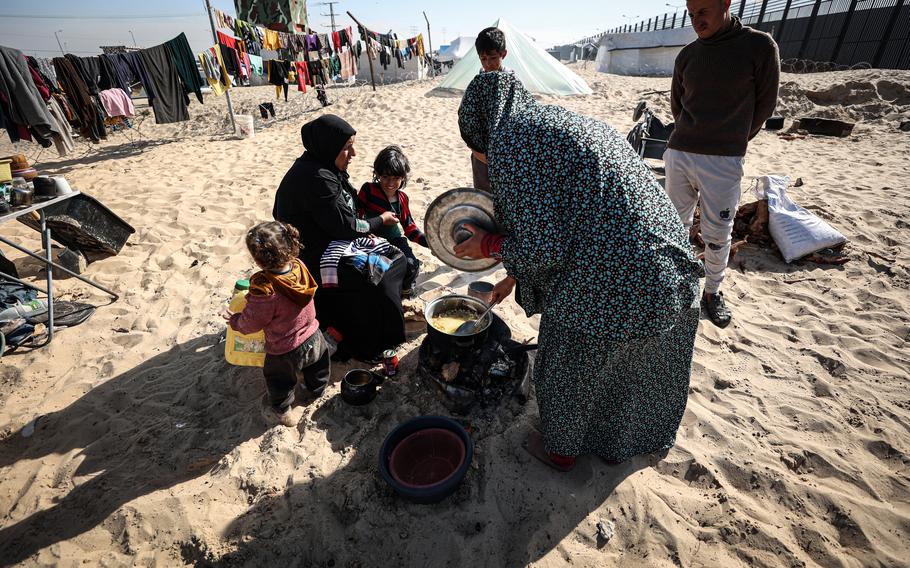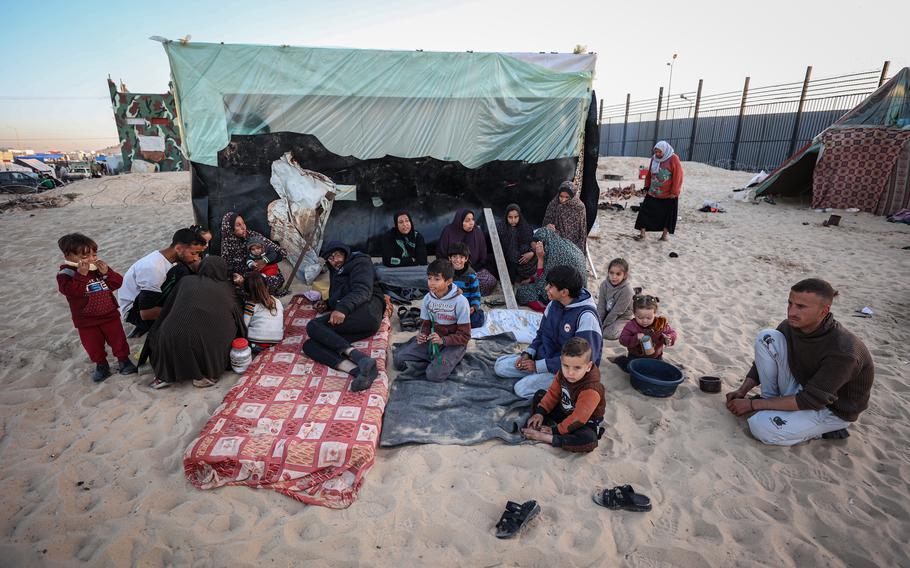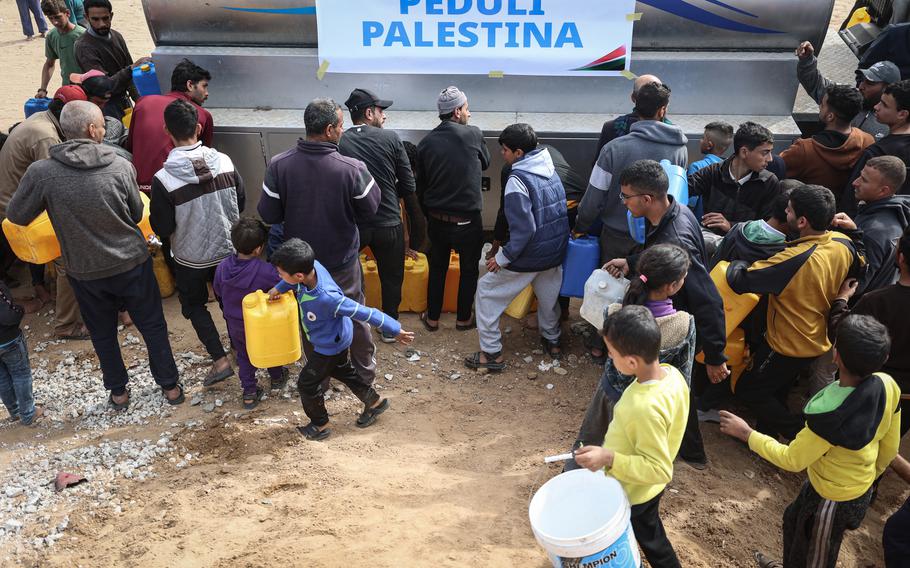Middle East
Gaza’s desperate hunger: Families struggle to fend off starvation
The Washington Post January 25, 2024

Shahinaz Nofal’s family cooks lunch inside a camp housing displaced people on the Egypt-Gaza border, south of Rafah, on Jan. 21, 2024. (Loay Ayyoub for The Washington Post)
JERUSALEM — Each day, for four days, Mohammad waited in line for a few pounds of flour. Returning home empty-handed to his five children, pained by hunger and humiliation, he ground up animal feed to bake over a makeshift stove.
“We don’t know how dangerous eating animal feed is to our health, but we have no other options,” the 40-year-old said by phone from Beit Lahia, in Gaza’s north.
“If the situation continues, you may see people dying [of hunger] in the streets,” said Mohammad, who worked as a driver before the war. Like others in this report, he spoke on the condition he be identified only by his first name, fearing retaliation from Israeli forces.
The Washington Post spoke to six families across Gaza about their daily struggle for food. Ninety-three percent of people there face “crisis levels of hunger,” according to a report published in late December by a U.N.-backed international consortium. More than half a million people — a quarter of the enclave’s blockaded and bombarded population — face “catastrophic hunger and starvation,” the report said.
“The scale and swiftness of this crisis is unprecedented in modern times,” World Food Program spokesperson Steve Taravella said last month. “If current predictions continue, we will reach famine by February.”
Israel rejected the report’s findings.
“There is no starvation in Gaza, period,” Col. Elad Goren, who heads COGAT, the wing of Israel’s Defense Ministry that oversees Palestinian civil affairs, told journalists Monday.
There is no estimate of how many Palestinians in Gaza have died directly or indirectly of hunger: With the vast majority of the population displaced and the medical system largely in ruins, many deaths have gone uncounted, or their cause undetermined. The few remaining hospitals typically only record deaths from Israeli attacks.
More than 25,700 Palestinians have been killed, many of them women and children, and 63,700 others wounded in Israel’s war against Hamas, according to the Gaza Health Ministry. The Israel Defense Forces says it has killed at least 9,000 militants. Thousands of Gazans are missing, believed to be buried under the rubble.

Shahinaz Nofal’s family gathers next to their tent south of Rafah on Jan. 21, 2024. (Loay Ayyoub for The Washington Post)
As the IDF shifts to what it says is a more targeted phase of fighting — partly in response to international pressure over the war’s staggering civilian toll — aid agencies warn that the greatest long-term threats to Gazans are hunger, disease and exposure to the winter cold.
The youngest are the most vulnerable. Mohammad says his 7-month-old son is dehydrated and malnourished. His hungry mother struggles to lactate.
Sabah Abu Ataya, 19, was displaced three times while pregnant with her second child. During her final trimester, she said she ate about once a day, usually something canned.
Wafa arrived early, on Dec. 15, a baby girl weighing less than 6 pounds.
“The doctors attributed this to the malnutrition that I was suffering from,” Abu Ataya told The Post on Wednesday.
The family fled fighting twice more in Wafa’s first month. On Jan. 16, they reached the relative safety of Rafah, in southern Gaza, Abu Ataya said. But she could barely produce any milk, she said; the baby breastfed once or twice a day.
On Friday, Wafa turned blue. Abu Ataya frantically rushed to a medical center, which sent her to an overrun hospital, which sent her to another.
Wafa was dead by the time they arrived. She was 35 days old.
“The girl died as a result of hunger and cold, and [still] the war does not end,” her mother lamented.
Israel and Egypt imposed a blockade on Gaza in 2007 after Hamas militants seized power. Even before the war, about 3 in 4 people in the enclave relied on the United Nations for food. After Oct. 7, Israel implemented a near-total siege. Aid was allowed in again after lengthy negotiations, but the process remains slow and inefficient — about 150 trucks pass daily through Egypt’s Rafah and Israel’s Kerem Shalom crossings after an Israeli inspection, down from about 500 per day before the war.
“If we want to prevent famine ... then we need to make sure that there is a significant increase in the humanitarian and commercial sector,” said Juliette Touma, of the U.N. agency for Palestinian refugees.
Israeli authorities accuse Hamas of stealing aid from civilians and say humanitarian groups are exaggerating the threat of hunger.
“You can see pictures from the Palestinian media, not that the IDF is publishing, about the markets, not just in the south but also in the north, with vegetables and fruits and bread,” said Goren, of COGAT. “I think that reality speaks for itself.”
As the trickle of aid has increased, more food products, such as canned meat, tuna and cheese, have become available. In some areas, prices of flour have leveled off and farmers have started harvesting winter crops.

Ibrahim, center, tries to fill a water jug in Rafah in the Gaza Strip on Jan. 21, 2024.. (Loay Ayyoub for The Washington Post)
But soaring inflation means few Palestinians can afford what’s for sale. Conditions are worst in the north, which is cut off by Israeli forces and largely beyond the reach of aid groups.
Mohammad Abu Sharkh, a neighbor of Mohammad’s in Beit Lahia, waited days in the same line for flour. Others he knew went north “to places where the [Israeli] army was in the hope of getting the canned goods left behind.” Some were killed, he said. Others returned with food.
Before the war, the 39-year-old had a coveted permit to work in Israel. His family ate well. Now, he says, his six children have lost weight. Their rib cages protrude.
“I give them only one meal a day, usually at night, so they can sleep without crying,” he said.
Reem, a mother of three in Gaza City, said she has lost nearly 30 pounds. The price of flour has shot up.
“There are no fruits or vegetables,” she said. “Nothing with vitamins. Nothing with protein.”
Reem worked in the humanitarian sector before the war. Now, she says her family lives off a dwindling supply of rice. Sometimes they find fortified biscuits from aid agencies.
When it’s safe enough, her husband and children spend hours outside looking for supplies; she stays inside caring for her immobile mother-in-law, who was injured in a strike. She frets constantly — about Israeli bombs and snipers, and about the increasing number of desperate Gazans who raid abandoned homes and aid convoys.
There is more food in Rafah, where a million displaced people have sought refuge, but it is not evenly distributed, said Mervat, 51, a onetime caterer in Gaza City.
“We see the aid coming but to who we don’t know,” she said by WhatsApp from a tent camp where she is living with relatives. “Even those who distribute aid, they give it to their friends. If you don’t know anyone, you won’t get any.”
Twice each week, Mervat goes to a U.N.-run school where she says she receives a few vegetables and a potato. She is diabetic and has developed a kidney infection, most likely from dehydration and an untreated urinary tract infection. She eats once a day, if at all.
Mervat is divorced and used to host her adult children for meals in her own apartment — an uncommon feat for a single woman in Gaza. That house and that life are gone.
Closer to the Egyptian border, Shahinaz Nofal’s extended family of 50 members live between a pair of tents in the sand. Three times displaced, the mother of six diligently rations a bottle of water and a can of meat, tuna or cheese she gets weekly from the United Nations.
On a good day, Nofal, 38, can find and afford macaroni, which she cooks over a fire made with nylon or paper scraps.
“I swear to God, we are even craving a cup of tea, but the price of sugar is so high,” she said.
One son keeps asking her for a single egg. She promises to buy whole cartons for him when the war is over.
Harb reported from London and Ayyoub from Rafah.